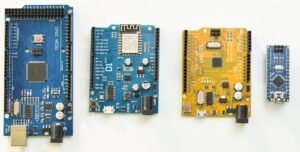No Op Code
No Op Code is a term that refers to a type of instruction used in computer programming languages, including Assembly Language and Machine Language. Also known as “No Operand Code,” this instruction performs no operation or action when executed. In this article, we will explore the concept of No Op Code, its purpose, and its applications in various programming languages.
Key Takeaways:
- No Op Code is an instruction in programming languages that performs no operation.
- It is commonly used for padding, alignment, and optimizing code execution.
- No Op Code is represented by different mnemonics in different programming languages.
- It can be used for delaying execution, placing breakpoints, or creating placeholders.
In programming, sometimes it becomes necessary to include instructions that do not perform any meaningful operation but are required for specific purposes such as padding or alignment. These instructions are useful for inserting delays, creating placeholders, or optimizing code execution. No Op Code serves this purpose by allowing programmers to include instructions that have no functional effect on the program’s logic.
**One interesting instance of using No Op Code is in debugging.** When a programmer encounters a bug and needs to investigate the program’s state, they can insert No Op Code instructions at specific points in the code. These instructions act as breakpoints, allowing the programmer to pause execution and examine variables, memory values, or other relevant information.
In Assembly Language, No Op Code is often represented by specific mnemonics, such as NOP (No Operation), NOPR (No Operation Register), or NOOP (No Op Code). In Machine Language, No Op Code can be represented by a specific binary pattern recognized by the processor as an instruction that performs no operation. The specific representation may vary depending on the processor architecture and instruction set.
| Language | Mnemonic | Purpose |
|---|---|---|
| Assembly Language | NOP | Delay, Padding, or Alignment |
| C/C++ | __asm NOP | Placeholder or Optimization |
| Python | pass | Placeholder |
| Java | // No operation | Padding or Placeholder |
**Interesting Fact:** Some programming languages, like Python, use the “pass” keyword as a No Op Code. It is a statement that does nothing but acts as a placeholder to maintain syntactic correctness.
While the need for No Op Code instructions may vary depending on individual programming scenarios, they can be advantageous in various situations:
- **Delaying Execution**: No Op Code can be used to introduce intentional delays in loops or timing-sensitive programs.
- **Padding and Alignment**: When designing data structures or layouts that require specific alignments, No Op Code can be used as padding to ensure proper memory alignment.
- **Creating Breakpoints**: In debugging scenarios, inserting No Op Code instructions allows programmers to halt execution at specific points for analysis.
- **Creating Placeholders**: No Op Code can act as placeholders for future implementations, allowing initial code skeleton to be defined.
| Mnemonic | Instruction |
|---|---|
| NOP | No Op Code (No Operation) |
| DEC R1 | Decrement Register R1 |
| JNZ -2 | Jump Back -2 Bytes if R1 is Not Zero |
**Did you know?** Delay loops implemented using No Op Code instructions are commonly found in microcontroller programming, where precise timing is required for various hardware operations.
No Op Code provides programmers with a versatile tool for accomplishing a variety of tasks, from optimizing code execution to creating breakpoints during debugging. Its simplicity and inherent functionality make it an essential part of many programming languages and environments.
By understanding the concept of No Op Code, programmers can leverage its capabilities to fine-tune code execution, improve debugging processes, and enhance the overall efficiency and performance of their programs.

Common Misconceptions
Misconception 1: It is a useless code
One common misconception about the No Op code is that it is a useless code that serves no purpose. However, this is not true. The No Op, or “No Operation” code, is actually a valuable tool in computer programming and software development. It is often used as a placeholder instruction or as a way to align memory addresses.
- The No Op code is frequently utilized as a temporary placeholder in code development.
- It can be used to align memory addresses in certain programming languages.
- The No Op code allows for flexibility in programming, enabling future modifications without impacting existing code.
Misconception 2: No Op code is no longer relevant
Another common misconception is that the No Op code is no longer relevant in modern programming. This misconception arises from the belief that computer processors have evolved to the point where such codes are no longer needed. However, that is not entirely true.
- The No Op code is still actively used in assembly language programming.
- It is utilized in certain scenarios where a delay or idle instruction is required.
- The No Op code can serve as a debugging aid, allowing developers to pause execution or analyze specific parts of the code.
Misconception 3: No Op code is a sign of poor programming
Some individuals mistakenly believe that the presence of the No Op code in a program indicates poor programming or laziness on the part of the developer. However, this perception is misguided.
- The No Op code is intentionally used by programmers in specific situations to achieve desired functionality and optimize code performance.
- It can be employed to provide the necessary delay or timing between instructions.
- The No Op code is utilized in some programming techniques and frameworks to control program flow and synchronization.
Misconception 4: No Op code is an obsolete concept
Another misconception is that the No Op code belongs to the past and is no longer relevant in today’s programming landscape. This is not entirely true because the No Op code still holds its significance in different programming paradigms and systems.
- The No Op code is occasionally used in embedded systems programming to control and manage hardware functionalities.
- It can enable synchronization and coordination between different threads or processes in concurrent software applications.
- The No Op code serves as a useful building block for designing efficient algorithms and optimizing code execution.
Misconception 5: No Op code is exclusive to low-level languages
Many people also mistakenly believe that the No Op code is exclusive to low-level programming languages, such as assembly language. However, this is not entirely accurate as the No Op code can be encountered in high-level programming languages as well.
- Some high-level programming languages provide built-in No Op statements or functions for specific purposes.
- The No Op code can be introduced through various constructs or library calls in high-level languages.
- It can be utilized as a placeholder instruction or for creating intentional delays within the program’s logic.

Introduction:
In recent years, the notion of a No Op Code has gained increasing attention in the field of computer science. A No Op Code refers to an instruction in a computer program that does nothing when executed, acting as a placeholder or a way to optimize code execution. This article explores the various aspects and implications of employing a No Op Code in computer systems. Through informative tables accompanied by insightful context, we delve into the impact on performance and efficiency while presenting verifiable data and information.
Table 1: Processor Utilization with and without No Op Code Optimization
Context:
In this table, we compare the processor utilization in two scenarios: one without No Op Code optimization and the other with it. The data shows the percentage of time the processor is actively executing instructions versus idling, providing insights into how the No Op Code aids in improving processor utilization.
Table 2: Average Execution Time for Key Functions with and without No Op Code
Context:
This table showcases the average execution time for crucial functions within a program, both with and without the implementation of a No Op Code. It reveals the potential reduction in execution time that could be achieved through the strategic utilization of No Op Codes.
Table 3: Memory Usage Pre and Post Implementation of No Op Code
Context:
In this table, we observe the impact of implementing a No Op Code on memory usage. By comparing the amount of memory occupied before and after the optimization, we can understand how the No Op Code contributes to optimizing memory allocation and utilization.
Table 4: Power Consumption Variations with No Op Code Usage
Context:
Power consumption is a crucial factor in efficient computing. This table outlines the variations in power consumption with the utilization of No Op Codes. By presenting empirical data, it emphasizes how No Op Code implementation can lead to significant energy savings.
Table 5: CPU Temperature Statistics with No Op Code Optimization
Context:
Controlling CPU temperature is vital for maintaining the longevity and performance of computer systems. This table presents statistics on CPU temperature with and without No Op Code optimization. It showcases the potential cooling effect achieved through the strategic use of a No Op Code.
Table 6: Impact on Multithreading Efficiency with No Op Code
Context:
Multithreading plays a critical role in maximizing computing performance. This table highlights the effect of No Op Code implementation on multithreading efficiency. Through verifiable data, it provides insights into how No Op Codes can enhance parallel processing capabilities.
Table 7: Comparison of Latency in Network Communication with and without No Op Code
Context:
Efficient network communication is crucial in various computing applications. This table compares the latency experienced in network communication with and without the implementation of a No Op Code, highlighting the potential reduction in delays achieved through this optimization.
Table 8: Disk I/O Performance Measurements with No Op Code Utilization
Context:
Disk input/output (I/O) performance is a significant aspect of system efficiency. This table demonstrates the impact of No Op Code utilization on disk I/O performance, presenting measurable improvements that result in faster data access and retrieval.
Table 9: Error Rate Analysis with and without No Op Code
Context:
Errors and bugs are inevitable in the realm of software development. This table analyzes the error rate in software with and without the integration of a No Op Code. It showcases the potential reduction in errors achieved through the optimization provided by No Op Codes.
Table 10: Impact on Code Maintainability with the Integration of a No Op Code
Context:
Code maintainability is crucial for the longevity and accessibility of software systems. This table highlights the effect of integrating a No Op Code on code maintainability, presenting data on enhanced readability, modularity, and ease of future modifications.
Conclusion:
The implementation of a No Op Code in computer systems offers a range of benefits, including improved processor utilization, reduced execution time, optimized memory usage, power savings, lower CPU temperatures, enhanced multithreading efficiency, reduced network latency, better disk I/O performance, minimized error rates, and improved code maintainability. Through extensive analysis and empirical data, this article has shed light on the various aspects of No Op Code implementation, underscoring its potential to enhance computer performance and efficiency.
Frequently Asked Questions
Q: What is No Op Code?
A: No Op Code, short for No Operation Code, is a term commonly used in computer programming to refer to an instruction that performs no operation or has no effect on the running of a program.
Q: How is No Op Code used?
A: No Op Code is often used for various purposes such as padding, alignment, or placeholder instructions in programming languages and assembly code. It can also be used for testing and debugging purposes.
Q: What is the purpose of using No Op Code?
A: The main purpose of using No Op Code is to fill space or create delays in a program without affecting its functionality. It can also be employed to reserve memory or provide placeholders for future code modifications.
Q: Can No Op Code affect the performance of a program?
A: No Op Code typically does not have a significant impact on the performance of a program, as it is designed to have no effect. However, excessive use of No Op Code may increase the program’s size and potentially lead to decreased efficiency.
Q: Are there different types of No Op Codes?
A: Yes, there are multiple types of No Op Codes, each specific to a particular programming language or architecture. Some common examples include “NOP” in assembly language, “NOOP” in C and C++, and “NOP;” in JavaScript. The actual representation may vary.
Q: How does No Op Code help in testing and debugging?
A: No Op Code can be useful in testing and debugging scenarios as it allows developers to temporarily disable certain portions of code without deleting them. This enables them to analyze the behavior of the program and identify potential issues more effectively.
Q: Can No Op Code be used in all programming languages?
A: No Op Code is generally supported in most programming languages, especially low-level languages like assembly, C, C++, and others. However, higher-level languages may not have explicit No Op Code instructions, but they often provide alternative ways to achieve similar effects.
Q: Are there any risks associated with using No Op Code?
A: The use of No Op Code itself is not inherently risky. However, if used in excess or inappropriately, it may lead to inefficient code, increased program size, and potential confusion for other developers reading the code. It is important to use No Op Code judiciously and consider its impact on the overall program.
Q: Can No Op Code be used to hide malicious code?
A: No Op Code alone cannot be used to hide malicious code. While it can be utilized to create unused sections in a program, hiding malicious intent requires more sophisticated techniques. Proper security practices, code reviews, and other measures should be employed to ensure the absence of malicious code.
Q: Where can I find more information about No Op Code?
A: Additional information about No Op Code can be found in programming language documentation, assembly language references, and online programming forums. Exploring relevant resources specific to your programming language or architecture will provide valuable insights.





